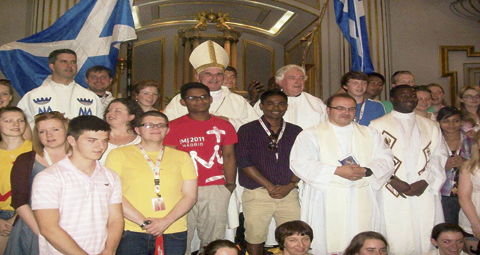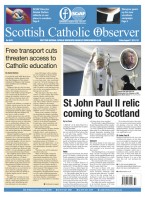September 2 | ![]() 0 COMMENTS
0 COMMENTS ![]() print
print

MEMORIES of Madrid can inspire faith
— CARDINAL KEITH O’BRIEN shares with us his experience of this year’s World Youth Day celebrations in Madrid and explains its importance with regards to New Evangelisation
Having already considered in the pages of the SCO, an outline history of World Youth Days, I want to share with you my impressions of the recent World Youth Day held in Madrid. We know that approximately 170 different countries of the world were represented at this great international gathering of approximately two million young people; with 50 Cardinals; hundreds of bishops; and tens of thousands of priests with the young people to help cater for their spiritual needs; and that the joyful and enthusiastic young people filled the streets, buses and subways, and the cafes of Madrid with their joyful enthusiastic presence accompanied by their very vocal singing.
Preparation
Having been associated with all of the World Youth Days except one since my appointment as archbishop some 26 years ago I realise the tremendous amount of work accomplished in each country sending representatives to the World Youth Days as well as of course in the host country as also in Rome through the youth section of the Pontifical Council of the Laity.
Each of the World Youth Days brings new experiences and here in Scotland we have learned more and more each time from our experiences of the previous World Youth Day. Consequently here in Scotland in each of our eight dioceses there were different preparations being made, different journeys being organised, and also different accommodation in varying circumstances being offered by our Spanish hosts.
Speaking of my own archdiocese there were days of retreat and information: talks on Spanish culture and Spanish spirituality; and information given on the real purpose of a World Youth Day. I myself was with our group from Edinburgh at Gillis Centre on the Saturday evening before their beginning of their journey by coach from Edinburgh at 1.30am. I reminded our young people that they were not going to any sort of T in the Park, rather they were going on a pilgrimage to meet with ‘Jesus in the Park.’ The purpose of the World Youth Day was to give all of the young peoples of the world an opportunity to have contact with Jesus Christ in the parks, in the streets, in the churches of the host city with an opportunity to meet Jesus in the face of fellow pilgrims, to meet Jesus in the Sacraments of the Church; and to meet Jesus in the person of Pope Benedict XVI.
Catechesis and prayer
Basic to each and every World Youth Day is the Catechesis which continues on and during the days before and after the arrival of the Pope. I myself was privileged to have been asked to give a succession of Catechetics from August 17-19 in a Jesuit college in Madrid; in the parish of San Francisco de Borja; and in the Basilica of Our Lady of Atocha. The structure of each Catechesis was outlined for the hundreds of cardinals and bishops conducting the Catechesis: A preparation with an animation team chosen from the group attending the Catechetics would begin at 10am; the Catechetics itself would be conducted by a bishop or cardinal for approximately 30 minutes; there would be personal and group reflection along with questions from the young people for the Bishop-Catechist; and then Mass would conclude the morning at about 12 noon with again a short Homily by the Bishop-Catechist.
Having given Catechetics on each of the three days I can assure you that it is no easy task keeping the attention of approximately 1000 young people in each of the different sites in the extremely warm temperature of a midsummer Madrid.
All of the Catechetics were based on the teaching of St Paul in Chapter 2, Verse 7 of his letter to the Colossians: “Planted and built up in Jesus Christ, firm in the Faith,” with different themes being chosen for each of the three days successively: Firm in the Faith; established in Jesus Christ; and witnesses to Christ in the world.
Invariably a host of different questions were asked of each bishop and as an indication of the thoughtfulness of the young people I give some of the questions of the young people whom I addressed from various English speaking countries throughout the world: “Tell us about your relationship with Jesus? What is the greatest challenge to your faith and how do you deal with it? How do we know that we are still firm in the Faith when God feels far away? How do we evangelise about Jesus to those of other faiths whilst promoting religious harmony and interfaith dialogue?
“Is everyone welcome in the Church; what advice would you give to a gay person who wants to have an active ministry? What is the biggest challenge facing the Church and what is the remedy for it? The complexity of modern life makes saintliness impossible to a great extent, what do you answer to us? Do you think that Christianity in the West has lost its intellectual credibility, that it isn’t considered as a real option for the thinking person could solid and firm apologetics help?”
These and a variety of other questions were presented to me during the course of my Catechesis with the initial Catechesis being facilitated by a group from Ireland; the second Catechesis facilitated by a group from the US; while a third was facilitated by a group from the United Arab Emirates. I was delighted to see that the Edinburgh Youth Group attended one of my catecheses on the Thursday, while the Youth Group from Aberdeen and also an Edinburgh University group of students were able to attend the Catechesis on the Friday. One can imagine too that discussion and questioning did not conclude in the church or hall in which the Catechetics was held, but rather continued among the young people afterwards with their priests or team leaders well into the night in their place of residence.
In the presence of the Pope
I myself stressed to the various groups which I was addressing that the purpose of a World Youth Day is not just to meet Christ in others nor indeed in the person of the Pope but to have their own personal meeting ‘face to face’ with Jesus in various different ways.
However, central and most important to any World Youth Day is indeed the presence of the Pope with these World Youth Days having been inaugurated by Blessed John Paul II and continued in a very wonderful way for three ‘Youth Days’ now in the presence of Pope Benedict XVI.
A tumultuous welcome was given to Pope Benedict when he arrived in Madrid and then received a formal welcome from everyone involved in the youth day on his journey from the Airport to Cibeles Park in the centre of Madrid on the Thursday evening. Following on from that welcome over the next few days the Pope conducted a number of other formal and informal meetings including of course meeting the King and Queen of Spain; an encounter with young nuns and then young university professors as well as lunching with young Catholics and having an official meeting with the President of the Government of Spain. In addition he heard the confessions of some young people and celebrated Mass for seminarians as well as meeting with the Spanish Cardinals and Bishops of the Madrid Province and the organising committee of this the 26th World Youth Day and, of course, meeting with disabled young people.
On the Friday evening of World Youth Day the Holy Father took part in the Stations of the Cross with young people in Cibeles Square, with each Station of the Way of the Cross represented by a float from the Spanish Holy Week processions, these floats coming from different Spanish dioceses. One might say that central to each World Youth Day is the prayer vigil and Mass—in Madrid celebrated in Cuatro Vientos air base on the outskirts of Madrid—where around the vast area were several marquees for the Adoration of the Blessed Sacrament during the night.
Accompanied by cardinals, bishops and priests, the Pope arrived at about 8.30pm at the Air Base leading the vigil until late into the evening. As has been widely publicised by now, the late evening celebrations were punctuated by a tropical like storm, with torrential rain accompanied by thunder and lightning. There were, of course, many cries of excitement from the young people—but all remained calm, including the Pope, who was surrounded by his aides, with each clutching an umbrella to protect him from the elements. As the storm calmed down, the Holy Father went down stairs to the temporary sacristy to change his sodden clothing before returning to continue with the Vigil, including Exposition of the Blessed Sacrament and Benediction, as if nothing had happened. The Pope returned to this great centre of prayer early the next Sunday morning to concelebrate Mass with thousands of bishops and priests and preach to the vast gathering on the importance of their union with Jesus Christ.
I said that this part of the World Youth Day is indeed central to all that has taken place. It is indeed like the celebration of an Easter Sunday morning after the commemoration of the events of Holy Week. The young people indeed showed that they were a people of prayer in the way that they spent the vigil night in prayer together in their language groups, despite the wet and cold of the night before; in the private time which they spent before the Blessed Sacrament in one of the Adoration marquees; or in forging again their own union with Jesus Christ through the Sacrament of Reconciliation.
Seeing the face of Jesus
Much work is involved in each and every World Youth Day. No one can really say just what the effect of these youth days have on the young people of the world. But one must say that something has indeed happened in the lives of hundreds of thousands of young people because of their contact with and listening to the teaching of the cardinals and bishops of the Church; their contact with Pope Benedict XVI and listening to his teachings; and most importantly of all from their contact with Jesus Christ and the other young people whom they are meeting in their Masses and Sacraments, their prayer and penance, and in their private devotions. Hopefully, memories of these days of prayer will long remain with the young people of the world and may they receive something of their reward here on earth in the ways in which they continue to see ‘the face of Jesus’ in the world and contribute their part to the New Evangelisation.











